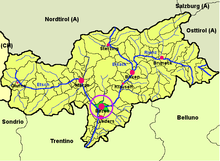Bozen-Bolzano
| Bolzano | |
|---|---|
| District | Bozen-Bolzano |
| Province | Bolzano (South Tyrol) |
| Region | Trentino-South Tyrol |
| Country | Italy |
| Population | 98.213 (2005), Language groups according to census of 2001 |
| 73% Italian 26% German 1% Ladin | |
| Sea level | 265 m |
| Area | 52.3 km² |
| City partnerships | Sopron (Hungary) |
| Postal Code | 39100 |
| Area Code | 0471 |
| ISTAT]]-Number | 021008 |
| Mayor (2005) | Luigi Spagnolli |
Bozen (German) or Bolzano (Italian) is a city in the Trentino-South Tyrol region of Italy; its 2001 population was 94,989, and the area of the municipality is 52.34 sq. km. It is the capital of the autonomous province of South Tyrol (German Südtirol, Italian Alto Adige). The province is officially trilingual (Ladin being the third spoken language). The province covers an area of 7,400 sq. km, with 116 communes and 462,999 inhabitants (2001 census). The province recorded a population gain of 5,1% from 1991 to 2001.
The province is almost completely mountainous, and is extended on the Adige (Etsch in German) valley north of the town of Salurn; other important rivers are Eisack-Isarco, forming Eisack-Isarco valley, and Rienz-Rienza, that flows in Puster-Pusteria valley. The easternmost part of the province belongs to the Drave basin, tributary of the Danube.
Bozen-Bolzano is internationally famous for the ice-mummy "Ötzi". Bozen-Bolzano is also the home of the Italian Army's Alpini High Command- COMALP and some of its combat and support units.
History
Initially inhabited by the Rhaetians, the area was settled by the Romans in 15 B.C., by general Nero Claudius Drusus, who gave the original town its Roman name, Pons Drusi. The city name later became Bauzanum. Bozen-Bolzano has been a trade city since its foundation and elevation to a city over 800 years ago, thanks to its location between the two major cities of Venice and Augsburg. Four times a year a market was held and traders came from the south and the north. The mercantile magistrate was therefore founded in 1635. Every market season two German and Italian officers (appointed from the traders who operated there) worked in this office. The city was a cultural crosspoint at that time.
In 1918, during World War I Trentino, South Tyrol and Bozen-Bolzano were occupied by Italians and thereafter annexed. During fascism many Italians moved to the city from southern Italy and, after a pact between Hitler and Mussolini, the majority of habitants of Bozen-Bolzano who spoke German had to choose between moving to Germany or assimilation (the so-called 'Opzione' or 'Option'). This period was very traumatic for the German-speaking population, and rivalries and tensions emerged between those who chose to emigrate to Germany and those who stayed. The people who remained preserved their cultural identity by organizing secret German schools, and by resisting to the imposition of the Italian culture in public life.
Society and Economy
After World War II ethnic tensions resurfaced, culminating in a wave of terrorist acts during the 1960's. After the implementation of a UN-brokered treaty between Italy and Austria, the province of Bolzano was given wide autonomy from the central Italian government and ethnic clashes have subsided. This, and the determined defense of their culture and language, has allowed the German speaking population to avoid assimilation.
Today 3/4 of the city inhabitants are Italians whose first language is Italian. The remainder speak German. Outside of the city Bozen-Bolzano the majority of inhabitants speak German as first language (according to 2001 census, there are approx. 330,000 German-speaking South Tyroleans among 475,000 inhabitants of South Tyrol). There are many bilingual people. A small minority of people speak Ladin.
South Tyrolean society is still to some extent segmented across ethnic lines. See the article on South Tyrol for more information.
Because of its special autonomy and the unique industrious and collaborative culture, Bozen-Bolzano is one of the richest cities in Italy. It enjoyes a very high quality of life, ranking consistently among the top cities nationwide.
The city thrives on a mix of old and new—high-quality intensive agriculture (including wine, fruit and dairy products), tourism, traditional handicraft (wood, ceramics) and advanced services. Heavy industry (machinery, automotive, steel) installed during the 1930's has been mostly dismanteled by now. On the downside, the local economy is very dependent on the public sector, and especially the autonomous Province.
Things to See
The city's germanic character, enhanced by the narrow cobblestone streets, Austrian-style churches and pervasive bilingual signage give it the unique flavor of a city at crossroads between Italian and Germanic cultures. This, and its natural and cultural attractions make it a renowned tourist destination.
Among the major monuments and sights are:
- Walther von der Vogelweide Platz, with a statue of the minstrel with the same name (Minnesänger in German),
- The Archeological Museum, which hosts the Ötzi mummy,
- The Gothic Cathedral, started in 1184, probably on the foundations of a Roman villa and rebuilt in the 14th Century by architects Martin and Peter Schiche (completed 1382),
- various castles, including Schloss Maretsch, Schloss Runkelstein and Sigmundskron,
- the First World War Victory Monument, a controversial monument built by Mussolini in 1928.
For more (historical & geographical) information, see South Tyrol.
City Districts and Neighboring Communities
City districts:
- Zentrum-Bozner Boden-Rentsch / Centro-Piani-Rencio
- Oberau-Haslach / Oltrisarco-Aslago
- Europa-Neustift / Europa-Novacella
- Don Bosco
- Gries-Quirein / Gries-San Quirino
Neighbouring communities: Eppan-Appiano, Kardaun-Cornedo, Leifers-Laives, Deutschnofen-Nova Ponente, Ritten-Renon, Jenesien-San Genesio, Terlan-Terlano, Pfatten-Vadena
Other important nearby towns are Brixen-Bressanone, Bruneck-Brunico and Meran-Merano.
Communications
Highway A22-E45 to Trento and Verona and to Innsbruck and Munich. Railway (main connection between Italy and Germany).
See also




